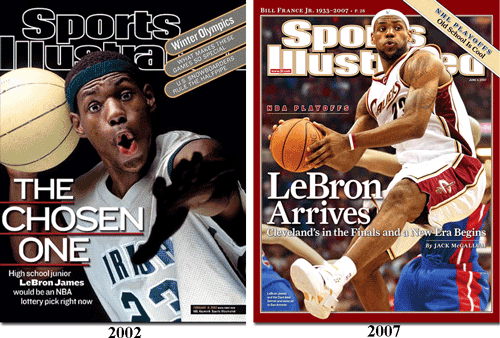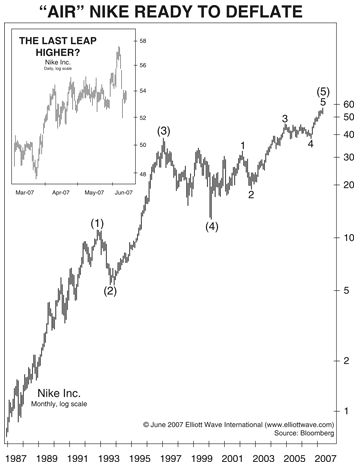
By many objective measures, like the value of the NASDAQ or the demand for high tech IPOs, the rally in social mood from 2002 to 2007 fails to measure up to the rally of the late 1990s. The difference is also readily apparent in the social realm where the U.S. is at odds with a host of foreign countries (in many cases the same ones it continually signed trade and peace initiatives with in the 1990s) and the Mideast is in a constant state of turmoil (see entry of May 15 for the latest Socio Times update)
Another big divergence from the heyday of the 1990s is glaringly apparent in the NBA. First recall that The Elliott Wave Theorist showed a close link between the game of professional basketball and the long-term rise in stock prices in a December 1996 Special Report called “Basketball and The Bull Market” (for a short excerpt see Additional References below). On that basis, we noted that the shares of Nike Inc., which relied heavily on the sport’s top superstar, Michael Jordan, would probably turn down when the trend reversed. After rising more than 9000% from October 1984, Nike topped two month’s later in a decline that actually preceded that of the overall market. Like the market as a whole, Nike surprised us by adding another leg to its long bull market. The most definitive part of the rally began with the bottom of the overall stock market in October 2002. Thus far, it has added another 50% to Nike’s market value. That’s a nice gain, but it’s still a far cry from the gain of more than 1000% from February 1990 to February 1997.
The weaker strength of the latest rally is also apparent in the Nike’s new basketball role model, LeBron James. Jordon’s career tracked the rise in stock prices to an uncanny degree (see “Michael Jordan’s Bull Run” chart in May 21, 2003 issue of The Elliott Wave Financial Forecast), and the early part of James’ career appears to be similarly attuned. It adheres nicely to a clear rise in social mood from 2002. The magazine covers shown above illustrate his emergence near the lows in 2002 and “arrival” at the top of the game as the Dow moved to a new all-time high on June 1. His starring role in the Eastern Conference Championship stamped him as the league’s marquee player in an exciting 6-game victory over the Detroit Pistons. In some ways, he’s ahead of Jordan as he made it to the Finals at a much younger age and is even more integral to his team’s success. But then, Michael Jordan never lost a Final, which LeBron is on the verge of doing this week. Also, by most accounts, the game around the league's new star is a shadow of what it was when Jordan was the focal point in the 1990s. Legions of former fans attest to the game's deteriorating internal condition. Here's how one blogger described the NBA's inferiority to its glory days of the 1980s and 1990s:
During the 1980’s, the NBA was the most exciting, well-played team sport in the world. While the Lakers and Celtics were dynasties, there were other great teams, as well. It has been chronicled many times about how Larry Bird and Magic Johnson brought the game to a new level, when they joined the NBA in 1979. No basketball players have made their teammates better than Bird and Magic.
During the 1990’s, the NBA became even more popular, as the star-power of Michael Jordan catapulted the sport to ratings only behind the NFL. This was also the time that the quality of the game began to slip, as the isolation play became a feature of most offenses. Clearing out most of the floor to allow the brilliant abilities of Jordan was often thrilling, but it damaged the free-form nature of the game.
After TV ratings and attendance fell in the first two years of the decade, basketball enjoyed something of renaissance. But its fortunes took a quick turn for the worse in early June as TV ratings for the finals suddenly tanked and LeBron’s team failed to compete in its first three NBA Finals appearances.

Meanwhile Nike shares turned down from a possible peak on the day Cleveland won its semi-final series over Detroit. The morning after the Cavs lost badly in Game 1 of the finals, Nike shares gapped down on the open. Nike is trying hard to fill the gap (shown in the inset on the chart) and climb back over a long-term trendline. It may do it. If it can continue to climb, new highs in the market as a whole will probably follow. But a precipitious fall in Nike should be near. The larger long-term chart shows how Nike boomed in a long five-wave rally that accompanied the bull market in stocks. This suggests that LeBron’s star may fade as the game backslides and Nike falls below the $13 low at the start of wave (5).
There’s already a huge discrepancy between TV ratings and ticket sales. While ratings are down dramatically from historic levels, attendance hit a new record of 21.8 million in 2006-2007. As with the Dow, however, the latest high is still only marginally above the 1990s high water mark of 21.3 million. The game’s inability to break away from the levels of the 1990s, suggests falling ratings is more representative of its future than the rising revenue, which is earned by demanding more and more of a dwindling fan base. Like an exhausted player, basketball has managed to run higher for a while, but a continued push to slight new attendance records in each of the last three seasons only means the collapse, when it finally comes, will be that much more dramatic. |
